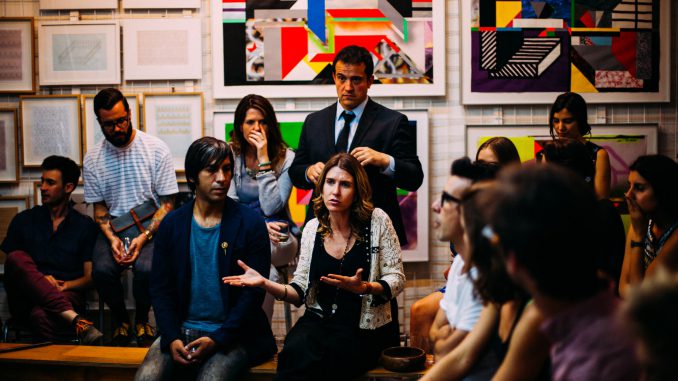
What are they?
Safe spaces came into existence to give people from a marginalised or persecuted group a way to meet, sometimes with political purposes, without having to defend themselves against prejudice or abuse. The first records of safe spaces refer to meetings in San Francisco to secretly organise for the decriminalisation of same-sex relationships. The term gained currency within the U.S. women’s liberation movements of the 1960s and ‘70s.
In universities they are intended to set up conditions for free and frank exchange of views, often related to social justice.
How can I set them up?
In safe spaces, the wellbeing of the marginalised group takes precedence. However, critics of classroom safe spaces[1] point out that students cannot be expected to share a common characteristic or political viewpoint, and therefore that safety tends to become confused with comfort and the absence of disagreement. In these circumstances, the social relations of privilege and marginalisation are unchallenged, and the status-quo remains untroubled. In response, Arao and Clemens[2] reworked their safe space ground rules as new rules for ‘brave spaces’.
| Some ‘safe space’ ground rules | Evolved into corresponding ‘brave space’ ground rules |
| Agree to disagree. | Controversy with civility. |
| Don’t take things personally. | Own your intentions and your impact. |
| Challenge by choice. | If you can choose not to be challenged, consider the impact of that choice. |
| Respect. | Distinguish between challenge and aggression. |
| No attacks. | Distinguish between opposing a view and attacking a person. |
Considerations
Avoid putting marginalised students to extra work
When marginalised students themselves are expected to educate their peers about exclusion, some may be willing to take up this role but for others:
“The “dialogue” becomes a one-sided stream of narratives, trauma, critical theory and lived experiences going from the marginalized to the not-marginalized, a “brave” space for privileged people to challenge their own preconceptions – and a miserable space for the marginalized people forced to do that labor of education.”[3]
“…if marginalized students are the only source of personal experiences of oppression, they are put in a bind: they must either disclose painful experiences or allow denigrating comments to stand. In either case, these students carry an excess burden that can make it difficult to perform well academically.”[4]
Consequently Verduzco-Baker[4] further modified Arao and Clemens’ brave spaces to incorporate the following approaches for educators:
| “Virtual” personal experiences.
Invite students to participate, but don’t force them to share their personal experiences in order to teach fellow students. Instead, deploy videos, blogs, etc. |
Productive challenges.
Assume nobody means harm (or behave as if you do). Correct problematic statements. Explain the misconception. Describe the harm it causes.
|
Educator’s role.
Give students opportunities to explain their reactions, but do not force: “Would you like to explain this, or shall I?” When students correct you, be open to being challenged. |
Different kinds of safety
Examining the relationship between free expression and freedom from threat, Callan[5] distinguishes between ‘dignity safety’ which is the desirable freedom from being humiliated as inferior in social rank, and ‘intellectual safety’ which is undesirable because incompatible with an open-minded education. He emphasises the role of civility in promoting dignity safety while also creating conducive circumstances for the intellectual risk-taking.
Appeals for civility have come under attack in recent years for maintaining the status quo and being unduly repressive of justifiable emotion. However, norms of aggression or scorn (which exceed disagreement or challenge) may allow the most strident participants to dominate, irrespective of the sentiment underlying their anger. These norms can be played by participants who hope to sow division and derail the discussion. This in turn may silence some participants who are ready to explore other viewpoints as carefully as they know how, but cannot muster the confidence to express their speculative views if they risk being scorned or shouted at. All that said, it may be that intense emotion does occasionally erupt, and needs to be met with compassion and (at some stage) curiosity.
Higher education demands intellectual risk-taking and dignity, which in turn requires distinguishing between challenge and aggression.
Further information
Prejudice, hurt or resentment tend to happen unevenly across subject areas, and can ambush us in unexpected contexts. Moreoever, for educators the line between dignity safety and intellectual safety can be hard to judge because indignities can be subtle. Consequently, enabling and sustaining tense discussions takes practice and may not always go well. Making a bit of space by taking time out to make explicit what is difficult about the discussion, show due care, and collectively prepare for a facilitated discussion may be helpful. The LARA method for tense talks was created for people who need to do this.
References
[1] Ali, D., 2017. Safe Spaces and Brave Spaces. Historical Context and Recommendations for Student Affairs Professionals, NASPA Policy and Practice Series. NASPA.
[2] Arao, B., Clemens, K., 2013. From Safe Spaces to Brave Spaces A New Way to Frame Dialogue Around Diversity and Social Justice, in: Landreman, L.M. (Ed.), The Art of Effective Facilitation: Reflections from Social Justice Educators. Stylus Publishing, LLC ; ACPA, Sterling, Virginia : Washington, DC.
[3] Zheng, L., 2016. Why your brave space sucks. The Stanford Daily. https://www.stanforddaily.com/2016/05/15/why-your-brave-space-sucks/
[4] Verduzco-Baker, L., 2018. Modified Brave Spaces: Calling in Brave Instructors. Sociology of Race and Ethnicity 4, 585–592. https://doi.org/10.1177/2332649218763696
[5] Callan, E. (2016). Education in safe and unsafe spaces. Philosophical Inquiry in Education, 24, 64–78. https://journals.sfu.ca/pie/index.php/pie/article/view/945 .
Image source: People meeting in a room by Antenna at Unsplash

Leave a Reply